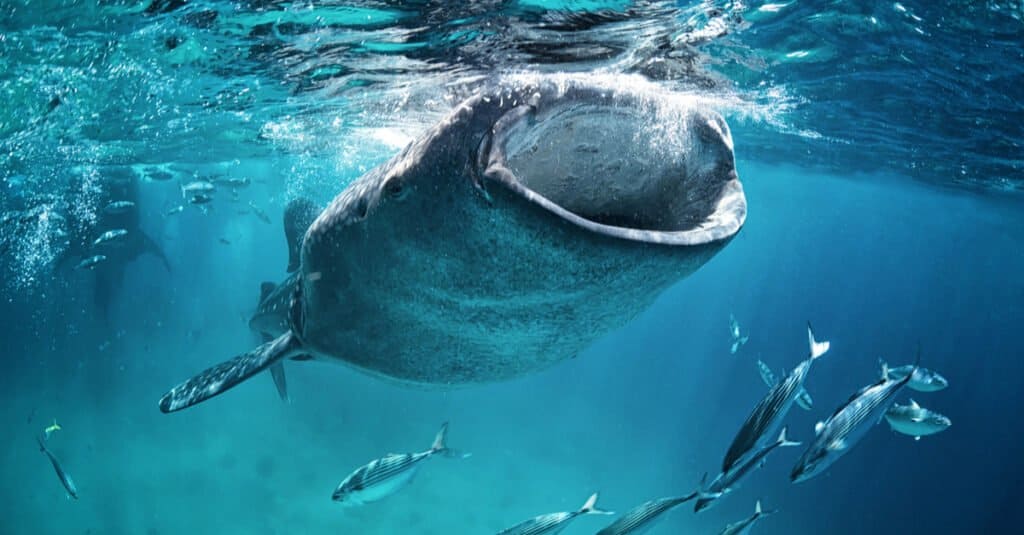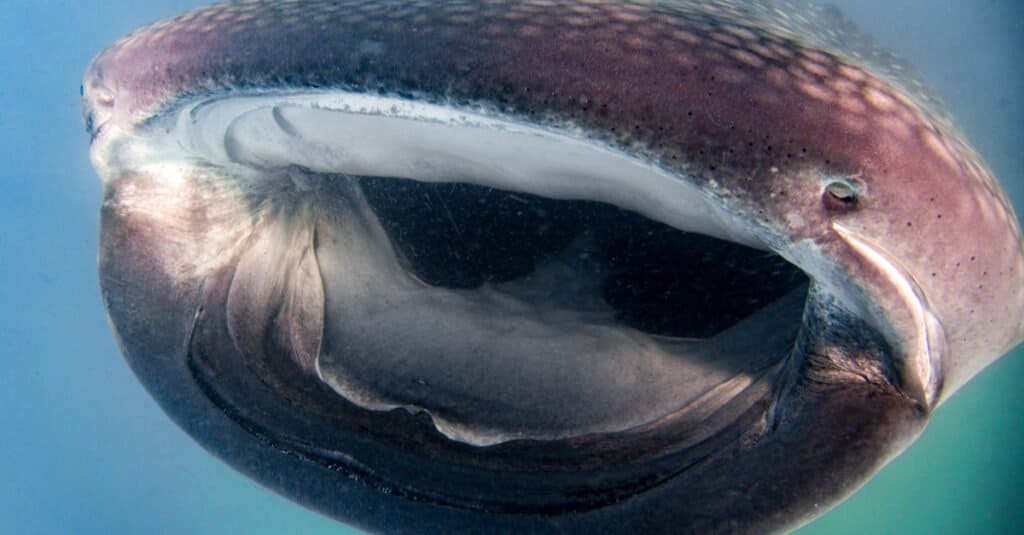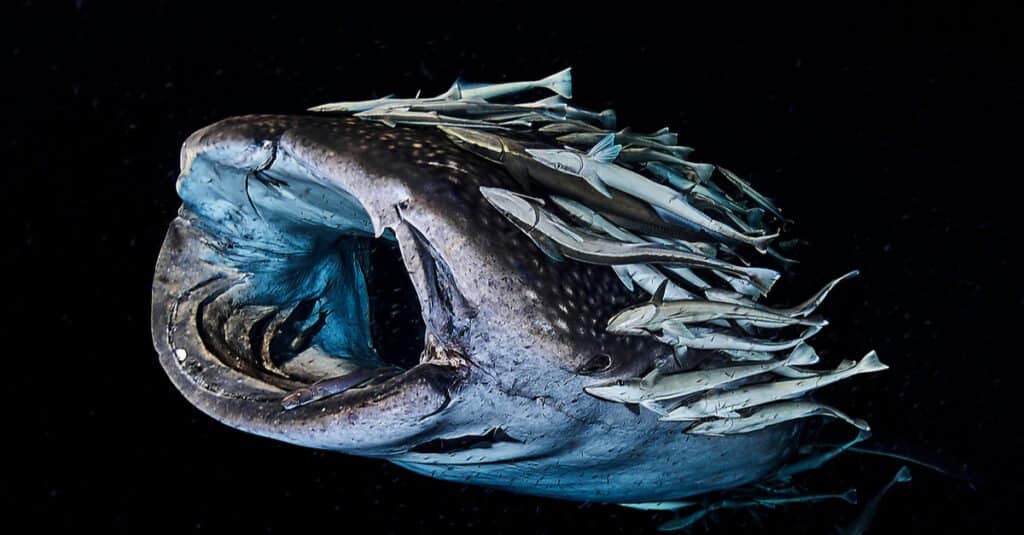Whale sharks are the largest fish in our oceans today. In fact, they may just be the largest fish to have ever lived in Earth’s oceans. These amazing fish can grow as large as 60 feet long and weigh tens of thousands of pounds. With all that mass, you may be wondering how they can get enough food to survive, especially if they aren’t true “whales.”
For these sea creatures, their size is reliant upon a few important factors, namely their diet and their mouths. If the whale shark didn’t have the teeth and mouths that they do, they simply wouldn’t be able to make it in the challenging environment that is the open ocean. Let’s take a look at whale shark teeth, as well as their mouths, to learn how they feed.
What is special about a whale shark mouth?

Whale sharks are filter feeders with a diet mostly consisting of krill, plankton, and algae.
©Fata Morgana by Andrew Marriott/Shutterstock.com
There are two things that people usually notice when they see a whale shark for the first time. The first and most obvious is their beautiful spotted pattern. Once you get past that, the second thing you notice is their massive mouths. On average, a whale shark’s mouth can stretch to 5 feet wide. For perspective, that’s like having a school bus with a vacuum hose the size of a doorway attached to the front of it while it drives around.
An additional note about their mouths is that they are located at the front of the head. For most other sharks, their mouths are located on the underside of the head. The whale shark is likely different due to its diet and lack of predatory capabilities.
Inside their mouths are teeth and filter pads. For a whale shark, filter pads are essential and act as screens to capture food passing through their mouths as they swallow water. There are typically twenty filter pads within a whale shark’s mouth.
Like many mouths, whale sharks’ have teeth, but not like our conventional understanding of a shark. Their mouths are filled with thousands and thousands of tiny teeth. In a typical mouth there are 300 rows, each filled with backward-facing teeth. Although these “teeth” may be sharp, they aren’t designed for actual eating or feeding.
How do their “teeth” work?

Whale sharks have teeth, but they are vestigial and they don’t use them.
©Andrea Izzotti/Shutterstock.com
A whale shark’s teeth are known as “vestigial” structures. A vestigial structure is an organ or structure that exists as a remnant of the past. These structures come about through evolutionary pressure and usually serve little to no purpose for the creature in modern times. In humans, wisdom teeth are easy examples of this. As our evolutionary ancestors transitioned away from diets primarily filled with tough fibrous plants and rock-hard nuts and seeds, the need for a grinding set of teeth became less necessary. Additionally, evolving humans needed more space in their skills for our big brains.
Whale sharks have evolved as filter feeders, meaning having sharp teeth isn’t necessary anymore. It’s possible that some ancient relative of the whale shark included larger prey in its diet, explaining the teeth. In modern times, however, whale sharks maintain the teeth but don’t use them for anything. Since having the teeth isn’t harmful to the shark, evolutionary pressure to get rid of them isn’t present.
Although they have teeth, humans have nothing to worry about while swimming in the ocean. Whale sharks may be large, but they aren’t predatory, and their teeth aren’t designed to capture prey.
How do whale sharks feed?

Using filter pads, whale sharks sift their food from the water like a kitchen sieve.
©Alex Rush/Shutterstock.com
Whale sharks are known as “filter feeders.” Filter feeders make up a large portion of the ocean’s creatures and include things like sponges, clams, and baleen whales. Filter feeders can be as small as a little mussel or as large as a blue whale. While whale sharks share the “whale” name with whales, the way they eat is different. Baleen whales use keratin filters in their mouths to filter water as it rushes out. For whale sharks, the method is a bit more passive.
Whale sharks have around twenty filter pads distributed through their mouths. As they swim, they open their mouths and allow large amounts of water to pass through their mouths and over these filter pads. The filter pads can be thought of as kitchen strainers that allow water through but not the food. They look like volcanic rock and have a latticework of tunnels that allow the water through to be passed on to the gills and expelled from the body.
As the shark pulls water into its mouth, the algae, plankton, and krill get stuck on the filter pads. When more water comes in, it pushes the food down the pad and towards the stomach.
Vertical feeding
The method is mostly passive as it allows the water to move the food into the mouth and eventually down its throat. However, many whale sharks use a method known as vertical feeding, allowing them to maximize their water intake in nutrient-rich zones in the water.
Sucking in air, the shark turns its body vertically with its head near the surface of the water. As it rises, it gulps in the nutrient-rich water directly near the surface. It then expels the air and sinks back down a few dozen feet. It then repeats the process, bobbing up and down over and over again as it clears the surface water of plankton, krill, and algae. The method is incredibly unique and is still the subject of study among scientists.
Whale shark feeding zones across the world
Whale sharks have a few favorite places to eat. They are migratory fish, meaning they travel around the world to get to their favorite spots to eat and breed. When it comes to feeding, there is an occasional biological trigger, for example, when land crabs start their spawning on Christmas Island, allowing them to eat absurd amounts of food. Additionally, whale sharks enjoy locations that have a shallow area next to a deep dive location. The slopes of the drop-off bring up nutrients from the deep. Also, the warm water near the surface is used to bring up their body temperature before deep-diving up to 1,900 meters.
Since these can’t be found everywhere, migrating to around twenty primary feeding zones is common among the species.
The photo featured at the top of this post is © Fata Morgana by Andrew Marriott/Shutterstock.com
Thank you for reading! Have some feedback for us? Contact the AZ Animals editorial team.






